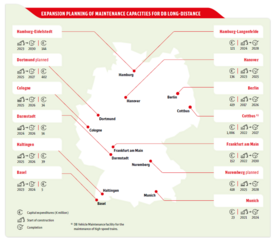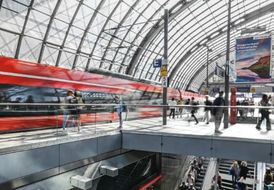Capacity expansion for a Strong Rail system
Expanding fleet and infrastructure capacity also significantly impacts quality, and above all, our punctuality.
Infrastructure expansion
In order to implement the Federal Government’s policy objectives for the transport sector, network capacity must be significantly increased. The Strong Rail strategy envisages an increase in volume produced of about 350 million train-path km, and thus by more than 30% (compared with 2015), for passenger and freight transport combined. According to available forecasts, growth will be disproportionately realized on the existing rail network, which is already highly utilized. At the same time as expanding infrastructure, we also need to ensure a high level of network reliability and capacity, even during the expansion phase. The capacity expansion of the rail network will lay the foundations for sustainable transport and economic development. Mobility is also indirectly facilitated. We can only achieve a high level of performance and growth in the network in cooperation with the Federal Government. To this end, Federal and state policy creates a precise legal framework (for example through LuFV, BSWAG), in which DB Group operates and is measured in terms of meeting the targets. There is a regular exchange with key interest groups on the effectiveness of the measures. Potential environmental impacts are continuously evaluated in accordance with statutory requirements (for example environmental protection, species protection, nature protection and water protection), as well as preventive and countermeasures to minimize environmental impacts (for example noise protection, compensation areas). The results are continuously reviewed in terms of target attainment.
The LUFV guarantees the financing of the existing network. In addition, there are three main levers to help increase the capacity of the network and the volume produced:
- New construction and expansion: The realization of new construction and expansion measures is a key factor for additional network capacity. We have the potential to create an additional 180 million train-path km (compared with 2015), laying the groundwork for more traffic on corridors and for new service concepts. Necessary projects for this are included in the Federal Government’s priority requirement plan and will be implemented successively. Additional measures supplement these projects, such as further expansion measures to enable Germany in sync or line extensions as part of the Structural Development Act (Strukturstärkungsgesetz). Small and medium-sized measures are also a key driver for robustness and growth.
- Digital Rail for Germany (Digitale Schiene Deutschland; DSD): With the nationwide roll-out of the European Train Control System (ETCS) in conjunction with digital interlockings and digital rail operations, we are increasing capacity by an additional 100 million train-path km (compared with 2015) – without building new tracks. DSD includes the completion of ongoing ETCS projects, the implementation of the so-called starter package and the industrialized comprehensive roll-out. In addition to capacity, the program increases the reliability, productivity and interoperability of the railways in Germany and Europe.
- Capacity management and customer-friendly construction: With further additional measures, we will be able to increase our volume produced by an additional 70 million train-path km (in relation to 2015). Improved capacity management is an important component of this. This includes coordinating capacity increases, customer-friendly construction, traffic optimization and disruption minimization. In addition, for the first time, there is contractual funding for capacity-efficient construction in the form of additional “customer-friendly construction” requirements in LuFV III. This demand for additional capacity helps further reduce capacity restrictions while construction work is taking place.

Fleet and depot expansion
We are continuously investing in the modernization and acquisition of new trains for a strong rail system. In order to meet the rising maintenance needs of the growing fleet, we are expanding our maintenance facilities and investing in new locations for operational maintenance.
By the end of 2030, we will be investing just under € 2.4 billion in the maintenance depots of DB Long-Distance and thus in improving the punctuality and quality of ICE and Intercity trains. New depots, larger halls and expanded workshops at existing sites and new maintenance facilities at local centers ensure that trains will be able to be maintained faster and more quickly in the future. When planning the new ICE facilities in Nuremberg and Dortmund Port, the involvement of public authorities and local people is a matter of course for us.
In addition to expanding the plants, we are optimizing our processes and are also exploiting the opportunities of digitalization and automation for operational maintenance. The main focus is on the automation of visual inspections on trains using camera technology and artificial intelligence, as well as the process optimization of elaborate maintenance levels.
In addition to our depots, we also invest extensively in vehicles. By the end of 2026, the long-distance transport fleet will expand to over 430 ICE trains. This includes 137 ICE 4 trains. Our fleet of ICE 4 trains has been delivered in full.
The ICE fleet continues to grow with the ICE 3neo. The first of the 73 new ICE 3neo trains has been in use since late-2022. We will also receive 23 ICE L and other Intercity 2 trains. With the increasing number of new vehicles, we are increasing the reliability of our fleet and creating additional seating capacity for our passengers.
In addition, we have commissioned the manufacturers Alstom Transport Deutschland and Siemens Mobility to develop a new vehicle concept independently of one another. DB Group will contribute its expertise as an operator to the development of the next generation of trains. Upon completion of the concept development, a further tender is expected to follow in the second half of 2023, which will include the development, construction and licensing of the new vehicles and will be open to other manufacturers. The new generation of trains is expected to be used from the early-2030s, replacing ICE 3 trains and expanding the ICE fleet. We rely on trains with a maximum length of 400 m and at least 300 km/h, single-deck trains with around 950 seats, which are to set new standards in terms of energy efficiency and technical availability.
More than 100 trains in the ICE 1 and ICE 3 fleets are being modernized to improve technical reliability and provide more comfort on board. Several measures are being implemented for the ICE T to stabilize the technical facilities. These include, for example, improving drive components to increase availability and refitting to ETCS Baseline 3 in order to enable use on the corresponding line networks.
The implementation of the Strong Rail transport targets at DB Regional aims to deliver a significant increase in passenger numbers. In this context, seat capacity must be increased by up to 30% by 2030. We will meet this additional demand both through increased capacity utilization of the trains in the medium term and by increasing the capacity of the vehicle fleet. In regional transport, too, we continue to invest in our fleet and depots. Extensive modernization work will be carried out over the next few years on the vehicles of the Dresden, Cologne, Rhine-Main and Stuttgart S-Bahn (metro) lines as well as in regional transport on the Elbe-Spree and North-South (Berlin-Brandenburg) networks. In addition to improving the technical reliability and comfort of the vehicles, we are also working to increase utilization.
For transport contracts with the Berlin, Hamburg, Rhine-Main and Stuttgart S-Bahn (metro) lines, the vehicle fleet is scheduled to be expanded with contracting organizations by the end of 2026. In addition, from 2025, battery-powered trains will be used in the Palatinate network (Pfalznetz), which can be operated locally with zero emissions, enabling even more climate-friendly regional transport. Additional single- or multi-level multiple units are being procured as part of the transport contracts awarded to service the additional train kilometers. In order to increase capacity on the existing rail network, vehicles will be equipped with ETCS. From 2023, for example, the vehicles of the Stuttgart S-Bahn (metro) will be equipped with this technology. The vehicles of the Hamburg S-Bahn (metro) will then be equipped from 2024.
Over the next few years, there will also be capital expenditures in regional transport workshop infrastructure to maintain and expand maintenance capacities. The focus until 2025 will be on workshops for the S-Bahn (metro) in Berlin, Frankfurt am Main, Cologne, Munich, Nuremberg, Tübingen and Ulm.
The implementation of the measures will be communicated using the usual methods, such as press releases.


